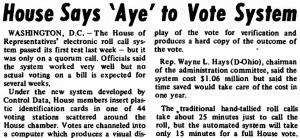Jan. 31, 1973: House of Representatives casts first electronic vote
An electronic roll call system became the first in a series of digital transformations in the House of Representatives.

On January 23, 1973, the United States House of Representatives cast its first electronic vote. The vote was used to conduct a quorum call, a process used to determine if enough representatives are present to do business. The development of the electronic voting system began in 1970 after the passage of the Legislative Reorganization Act, which was the first bill related to electronic voting to pass after over 175 years of completely manual votes in the House.
Each of the 435 members of the House voted by inserting a plastic identification card in one of 44 voting stations installed around the House Chamber, according to an article in Computerworld magazine. From there, the data was passed to a computer which produced both a graphical display of the vote and a hard copy for archival purposes. The electronic voting system was expensive, costing just over $1 million dollars, but was expected to make up its cost in time saved. The system was developed by Control Data Corporation, a major computer company at the time.
Today, the vast majority of votes in the House are collected and tallied electronically, using a modernized system in which members vote on stations attached to the rows of seats throughout the House Chamber. The Senate continues to record their votes manually.
–By Kathleen Esfahany